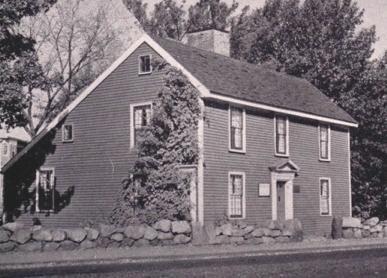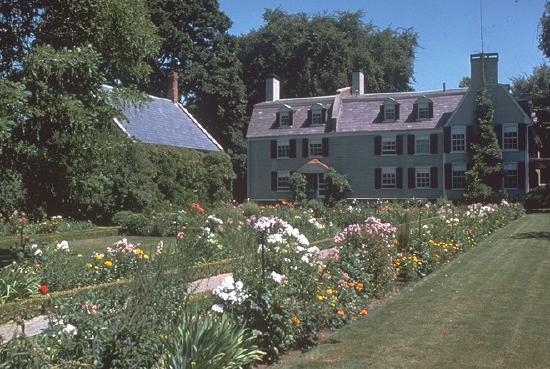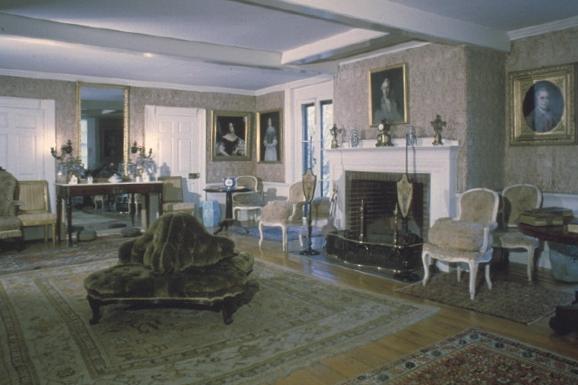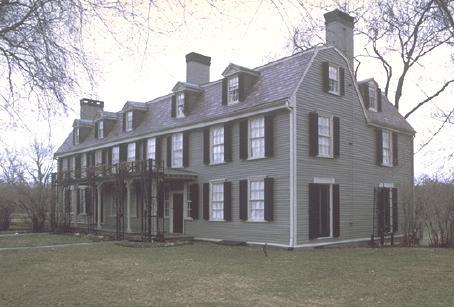| |
Home
Famous and Fascinating Women in History
Frontiersmen and Women
The World's Greatest Composers
Famous Women Spies
Great Authors of the World
Generals and other Noteworthy People
from the Civil War
The Presidents of the United States
The First Ladies of the United States
Homes and Monuments of and to
Famous People
Historical People and Events by Month for Each Day of the Year!
Famous Figures in Black History
The Calvert Family and the Lords Baltimore
Understanding the American Revolution and its People
Everything Beatles!
Everything Maryland! |
| |
|
 
|
 |  | 
John Adams
and his Homes
By John T. Marck

John Adams,
second president of the United States, was born on October 31, 1735,
in Braintree, Massachusetts, in what is today the town of Quincy. In
1636, John's great-grandfather, Henry Adams, received a grant of
approximately 40 acres of land in Braintree, and soon thereafter
immigrated from Devonshire, England with his eight sons. The saltbox
house in which he was born still stands today and is a part of the
National Historic Site in Quincy.

John Adams, (the
future president) was the son of John Adams and Susanna Boylston, the
daughter of Peter Boylston of Brookline, Massachusetts. The future
president's father, John, was well thought of in the community, and
was a part-time shoemaker, a farmer, deacon of the church, and upon
his death in 1760, had an estate appraised at 1,330 pounds 9shillings
6pense, which at the time was regarded as a moderate competence.
In these days it
was the custom of the family to send the eldest sons to college, and
Adams attended Harvard, graduating in 1755. While deciding on a
profession, Adams taught at a grammar school in Worcester. His family
however, thought that by sending him to college he would become a
clergyman, but Adams found he was a “free thinker,” and thus was not
at home in the pulpit. He turned from the ministry and began to study
law at Worcester, and in 1758, opened his own practice in Suffolk
County.
While still a
struggling small-town lawyer of 29, in 1764, Adams married Abigail
Smith of Weymouth; a 19 year-old daughter of a clergyman and a lady of
social position higher than his own.
Abby
as she was known was a lively and intelligent lady, and one of the
most distinguished First Ladies. She was a writer of countless letters
which are a treasure of information for the times, and was the only
wife of a President and mother of another (John Quincy) for years,
until the election of George W. Bush.
John Adams became
known for the fierceness in which he attacked anything he strongly
disapproved of. This trait became apparent when the British Parliament
imposed the Stamp Act on the colonies in 1765. Along with Samuel
Adams, a second cousin, he stirred up a mob action against the
British. Adams introduced successful anti-tax resolutions and wrote
articles of protest in the Boston Gazette. After moving
his law practice to Boston in 1766, Adams demonstrated his moral
courage in his most famous case, defending the British captain and
soldiers who had fired into a mob in the Boston Massacre. While Adams
believed that this case might cost him popularity, he still believed
that the crime lay with British authorities rather than the troops who
were simply carrying out their orders. Although Boston patriots
denounced him for defending Englishmen, he won the case and also wide
respect for his sense of justice.
In his political
career prior to serving as President, Adams proved to be eloquent and
forceful as a member of the Continental Congress from 1744-1778. It
was he that proposed George Washington as Commander-in-Chief of the
Continental Army, and helped draft the Declaration of Independence.
During the Revolutionary War he served in France and Holland in
diplomatic roles, and helped negotiate the treaty of peace and helped
draft the Treaty of Paris that ended the war. From 1785 to 1788 he was
minister to the Court of St. James's, returning to be elected Vice
President under George Washington. He also served as the
Minister to the Netherlands in 1780, and Minister to Great Britain in
1785. It was also Adams, and others, who wrote the Massachusetts State
Constitution, which Madison used as a model in writing the
Constitution of the United States.
In 1789, John Adams
entered “the most significant office that ever was the invention of
man contrived or his imagination conceived,” --- that of the
Vice-Presidency. During his terms with George Washington, two
distinct political groups emerged; the conservative Federalists and
the Democratic-Republicans. Nominally a Federalist himself, and
partial to the “rich, the well-born, and the able,” Adams nevertheless
feuded with Federalist leader Alexander Hamilton.
In the presidential
election, Adams defeated Thomas Jefferson (who became his
vice-president) by 71 to 68 electoral votes in 1796 when Washington
refused to serve a third term. Opponents to Adams, disappointed
by the election, disparaged him as “President by 3 votes. When Adams
suggested establishing an elaborate title for the Presidency, like
that of European royalty, he was mocked as "His Rotundity.”
Still, when the 61
year-old Adams was sworn in on March 4, 1797 at Philadelphia, then the
nations capital, the ceremony demonstrated to the world that the new
republic could change chief executives in an orderly, peaceful manner.
One of Adams'
greatest mistakes was that he carried over into his administration all
the members of Washington's Cabinet; men not of his choosing or he
theirs. Consequently, his four years in office were scarred by
intrigues, which embittered all his later life. Some of his Cabinet
members turned to Hamilton rather than to him for political
leadership, deepening the breach.
The most serious
was the crisis in relations to France. In an undeclared warfare
action, the U.S. Constitution ("Old Ironsides"), the United
States and the Constellation, cleared the sea-lanes of
French privateers. The Alien and Sedition Acts empowered the federal
government to imprison aliens and citizens who threatened or opposed
it. When Adams used these acts as an opportunity to frustrate
his enemies at home, and especially when he made peace overtures to
France, Hamilton circulated a letter to Federalist leaders declaring
Adams to be unfit to continue in office. This certain sabotage along
with Jefferson's popularity ended Adams' chance for a second term.
In spite of the
controversy, Adams can be respected as a President who steadfastly did
what he believed was right, regardless of popularity, and who saved
the United States and France from the devastation of a full-scale war.
John Adams lived 90
years and 8 months, longer than any other President until Ronald
Reagan surpassed him recently. In retirement Adams spent
much of his time writing. He penned many an elaborate letter to
Thomas Jefferson, his rival but close friend. John Adams died on the
Fourth of July, 1826, and (some say) from his deathbed whispered,
“Jefferson lives.” However, unknown to Adams, Thomas Jefferson had
died earlier this same day, on the 50th anniversary of the
Declaration of Independence.
The Homes of John Adams
The
Adams National Historic Site

John Adams, the
second President, and his son, John Quincy Adams, the sixth President,
both were born in adjacent houses on Franklin Street in Quincy, which
at the time of their births was known as Braintree.
The house at 133
Franklin Street, shown herein, is a New England “saltbox” building
with multiple fireplaces around a central chimney.
Originally it
consisted of two upper and two lower rooms, but rooms were added to
both floors. The house dates to about 1680 and thus is the
oldest existing of all the Presidential birthplaces.

Upon his father's
death, John Adams (the future President) inherited a similar house
next door that became his home and law office, and the birthplace of
his son, John Quincy as well as the Massachusetts State Constitution.
Both houses are typical of those built in the late 17th
century by New England carpenters. The houses were framed with huge
beams that were secured with wooden pegs, floored with wide planks,
and covered with clapboard siding over brick-filled walls to help with
the cold New England winters.
John Adams spent
much of his time in Europe in his various diplomatic positions.
During this time, his wife, Abigail, purchased, sight unseen, a farm
and house less than two miles away from Franklin Street. Major Leonard
Vassall, a wealthy West India sugar planter, had built this house in
1731.
This house, called
Peacefield, or commonly known as The Old House, consisted of six rooms
and a kitchen wing. Just as Adams was preparing to settle into his new
home, he was called away by George Washington to serve as his vice
president. Thus, it would be twelve years before he would retire
there, serving eight years with Washington, and another four as
president. During the twelve years he was away, his wife Abigail
was busy overseeing major improvements to the house that included
doubling the capacity with an addition of an east wing in 1800. Years
later, her great grandson Henry Adams recalled the following about The
Old House:

“The Old House at
Quincy was 18th century. What style it had was its
Queen Anne mahogany panels and its Louis XV chairs and sofa. The
panels
belonged to an old colonial Vassall who built the house; the
furniture had been brought back from Paris in 1789 or 1801 or 1817,
along with porcelain and books and much else of an old diplomatic
remnants; and neither of the two 18th century styles...was
comfortable for a boy, or for anyone else. The dark mahogany had
been painted white to suit daily life in winter gloom.”
Finally at long
last, John joined Abigail and he began to enjoy the gardens, his
books, and his children and grandchildren.
Over the years
since he lived there, much has changed at Peacefield, but the
present-day garden and beauty offer a link to the serenity of the
earlier times. A white York rose brought to Peacefield from England in
1788 survived and still thrives today. As one walks the gravel paths
through the orchards and gardens today give a renewed sense of the
history, tradition and quietude of Peacefield.
Although John
Quincy Adams loved The Old House and inherited it from his parents, he
was too busy with politics to pay any attention to it.
Consequently he left the supervision and maintenance of Peacefield to
his son, Charles Francis Adams. In the middle of the 19th
century, Charles converted the property from a farm to a country
gentleman's home as well as added a separate building, which became
The Stone Library. It was here that John Adams extensive collections
were kept.
For generations,
the Adams's remained in The Old House, until 1927 when the Adams
Memorial Society was formed and took possession of the home. In 1946
the Society deeded Peacefield to the federal government. The
birthplaces of John and John Quincy, owned by the city of Quincy were
also given to the federal government. These two areas, separated
by less than two miles are today considered a single National Historic
Site, controlled by the national Park Service. The Adams National
Historic Site is open from April to November each year. A splendid
time is guaranteed for all.
The United First
Parish Church (Unitarian) Of Quincy is considered the finest existing
Greek revival church in New England. The dominant interior feature is
the decorative plaster dome. The church is the burial place of
Presidents John and John Quincy Adams and their wives. John Quincy was
instrumental in its erection in 1827‑28.
Quick Biographical Facts
JOHN ADAMS
2nd President
Term- March 4, 1797 to March 4, 1801
Federalist Party
Birth: Braintree (Quincy), Massachusetts, October 30, 1735.
Ancestry: English
Father: John Adams
Mother: Susanna Boylston Adams
Marriage: Weymouth, Massachusetts, October 25, 1764 to Abigail
Smith, who was born in Weymouth, Massachusetts, November 11, 1744.
Abigail died in Quincy, Massachusetts on October 28, 1818 and is
buried at the First Parish Church, Quincy, Massachusetts.
Children: Abigail Amelia (1765-1813); John Quincy (1767-1848);
Susanna (1768-1770); Charles (1770-1800) and Thomas Boylston
(1772-1832).
Home: Peacefield, Quincy, Massachusetts.
Education: Attended private schools in Braintree; received B.A.
(1775) from Harvard.
Religion: Unitarian
Occupation before Presidency:
Teacher, farmer, lawyer.
Pre-Presidential Offices:
Representative to Massachusetts General Court; Delegate to First and
Second Continental Congresses; Member of Provincial Congress of
Massachusetts; Delegate to Massachusetts Constitutional Convention;
Commissioner to France; Minister to Netherlands and England;
Vice-President.
Age at Inauguration: 61
Adams Administration: Vice-President: Thomas Jefferson, Inauguration
March 4, 1797, Federal Hall, Philadelphia, Pennsylvania.
Occupation after Presidency:
Writer
Death: Quincy, Massachusetts, July 4, 1826
Cause of Death:
Debility at age 90
Place of Burial: United First Parish Unitarian Church, Quincy,
Massachusetts.
Interesting Facts:
The White House was
first known as the Presidential Palace, and was unfinished when Adams
moved in. The Adams' were the first residents of the White House. They
moved in in November 1800 while the paint was still wet. Mrs. Adams
would hang her laundry in the East Room to dry.
The 44-gun frigate
USS Constitution was first launched during Adams Presidency, in 1797.
She was nicknamed “Old Iron Sides” because of the strength of her oak
timbers.
Adams was one of
three presidents not to attend the inauguration of his successor. Not
only was Adams disappointed in losing to Jefferson; he was also
grieving the death of his son Charles.
Adams was the
great‑great‑grandson of John and Priscilla Alden, Pilgrims who landed
at Plymouth Rock in 1620.
The only presidents
to sign the Declaration of Independence, Adams and Jefferson both died
on its 50th anniversary, July 4, 1826. Adams' dying words were
"Thomas Jefferson lives.” Jefferson, however, had passed on a few
hours earlier.
John
Adams was a second cousin to Samuel Adams, and a third cousin to his
own wife, Abigail Smith Adams.
Adams was one of
three presidents to live beyond his 90th birthday.
When Adams and his
family moved to Washington to live in the White House, they got lost
in the woods north of the city for several hours.
Copyright ©
John T. Marck. All Rights Reserved. Grateful appreciation and
informational assistance from the Adams National Historic Site.
Photographs compliments of the Adams National Historic Site.
Information in part on The Homes of John Adams from “Homes and
Libraries of The Presidents,” by William G. Clotworthy, 1994, McDonald
& Woodward Publishing, Blacksburg, Virginia. Henry Adams quotation
passage from “The Homes and Libraries of the Presidents,” by William
G. Clotworthy, 1994, McDonald & Woodward Publishers, Blacksburg,
Virginia. Quick Biographical Facts from “The Presidents of the United
States,” by John T. Marck, Copyright©1993,1997.
A
Splendid Time Is Guaranteed For All
| | |
|
|

